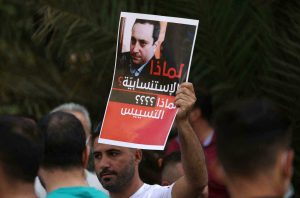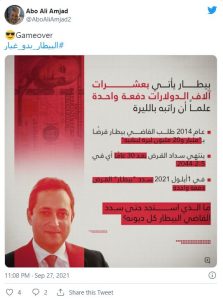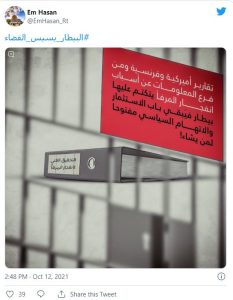The lead investigator in the Beirut port explosion probe, Tarek Bitar, has been the target of a cabal on social media after the judge attempted to question a number of senior Lebanese officials, who seem to be determined to engage in all kinds of ploys in a bid to evade justice and sabotage the investigation, like reported by lorientlejour.com.
Numerous Arabic hashtags have made the rounds on social media attacking Bitar, accusing him of “politicizing the investigation,” with some online users criticizing what they called “the fitna [meaning an attempt to sow discord] of Bitar’s nitrate.” More recently, the hashtag “Bitar has blood on his hands” has been trending, following the deadly gunfire that erupted in Beirut’s Tayyouneh area on Thursday, killing several Hezbollah and Amal supporters who were demonstrating and calling for Bitar’s dismissal.
These are some of the many hashtags and slogans that can be found on Twitter, Facebook and Instagram targeting the lead investigator, who, since February, has been leading the probe into the 2020 Beirut port explosion that left at least 218 dead and devastated entire neighborhoods of the Lebanese capital.
The smear campaign against Bitar has been mainly carried out by the “electronic army” of Hezbollah and its ally, Amal.
L’Orient-Le Jour has chosen to mainly focus on Twitter to examine the trending comments and hashtags that have emerged since the judge was removed for the first time on Sept. 27, following a complaint filed before the Beirut Court of Appeals by MP Nouhad Machnouk, one of the top-ranking officials who Bitar has implicated in the investigation.
“Bitar is out of here,” “Bitar must be replaced” or simply “Tarek Bitar” are among the hashtags that have been trending, often accompanied by a defamatory message or photo of the judge.
While Machnouk clearly does not belong to either Hezbollah or Amal, the majority of the Twitter profiles spreading defamatory slogans and hate speech appear to be strongly affiliated with the “Party of God.”
This can be clearly seen through their profile pictures, which are often that of Hezbollah Secretary-General Hassan Nasrallah or Iranian Revolution leader Imam Khomeini, or through propaganda messages in favor of the Shiite party that they often share on their pages.
Who is this electronic army?
Hezbollah is far from having missed out on the digital revolution. On the contrary, the powerful militia has managed to create its own propaganda on social media by dodging surveillance and restrictions on posts that go against Facebook and Twitter’s community standards.
Like all other political parties, Hezbollah is well aware that social networking sites, along with the control of media outlets and of visuals, have become an essential tool of power — a tool that the party also uses to intimidate opponents and critics and to undercut any project that does not work to its advantage.
Hezbollah’s electronic army has been working at full throttle to disseminate disinformation online, with a clear attempt at manipulating and mobilizing its partisans.
“This army is made up of fake Twitter accounts, trolls, ordinary supporters and influential public figures who would mobilize to undermine any issue that does not serve Hezbollah’s interest, as is the case with the port investigation,” Jad Shahrour, communication manager of the Samir Kassir Foundation, explains.
L’Orient-Le Jour took a closer look at the profiles or accounts sharing content attacking Bitar and found that most fall into one of the electronic army’s typical categories.
Some pages have fake profile pictures with a name written in code and few interactions with other users but prolific activity online in relaying propaganda messages. (Here is one example: https://twitter.com/hussein141148?s=20).
Other profiles are difficult to identify. These have a large number of followers but are not well-known figures.
This user, for instance, seems to be dictating the trending hashtags for other internet users. In the picture below, the user, portrayed as a woman in their profile, is asking followers to use the hashtag “Bitar is playing with fire.”
There are also the pages of public figures, like journalists from the Hezbollah-affiliated al-Mayadeen and al-Manar television channels, who have tens of thousands of followers and whose messages usually have a resounding impact, given the high numbers of retweets or shared messages.
For instance, al-Mayadeen journalist Ali Mortada garnered nearly 900 “likes” on a post deriding Bitar following Nasrallah’s Oct. 11 speech in which he castigated the lead investigator.
The hashtags echo Nasrallah’s messages
This online lynching is usually preceded by fiery political speeches that set the tone for social media reactions.
It is important to recall the series of events that led up to the online harassment of the judge, who is in charge of the largest case in the country’s history and who has so far been benefiting from fairly broad support in Lebanese civil society.
On Sept. 21, Bitar allegedly received a threatening message from Hezbollah security chief Wafic Safa, who reportedly said, “We’ve had enough of you. We will go to the end of the legal path, and if that does not work, we will get rid of you.”
The statement was not met by support campaigns online, as the Shiite party’s supporters initially questioned the veracity of these remarks, while Hezbollah remained silent on the matter.
The real turning point was when Bitar was temporarily removed from the case. The defamation campaign began to pick up steam as officials close to Amal and Hezbollah began to publicly criticize the lead investigator.
On Oct. 10, Amal MP Ali Hassan Khalil said the investigation was “highly politicized” and “selective,” calling for Bitar’s removal.
On the same day, Hassan Ezzedine, a Hezbollah MP, said that the United States had been manipulating the case led by Bitar.
The judge soon became the target of a campaign accusing him of “politicizing the case” — a hashtag that made the rounds on social media, especially on Amal supporters’ pages and accounts.
Then Hassan Nasrallah harshly lashed out at the magistrate in a discourse on the evening of Oct. 11. Hezbollah’s number one in command accused Bitar of “political targeting,” as he had not sought to question President Michel Aoun, his predecessor Michel Sleiman, or the former prime ministers who were in office before Hassan Diab. “You will never get the truth with this magistrate,” Nasrallah told the victims’ families, in an obvious attempt to discredit the 4-year-old judge.
The cabal mushroomed on Twitter. “The same chronological order is followed every time. As the party seeks to dismiss a case like this, its officials will adopt a discourse against Bitar. Then, the media close to the party will repeat the same language of criticism against the judge. Finally, the digital army will take the file to social media. Hate messages were clearly seen pouring in a heartbeat after Nasrallah’s speech that evening,” says Shahrour.
The core of Nasrallah’s criticisms is echoed in the slogans, along with images often crafted by “al-Haya al-Tansikeya,” a coordinating committee (as it presents itself on its site) which has chosen to disseminate the values of the “resistance” on social media. On Twitter, Tansikeya was diligent in setting the tone for the anti-Bitar campaign, posting almost every day since Sept. 27 various slogans and images defaming him and accusing him, in particular, of acting under the Americans’ cover.
The hashtags took a more aggressive twist after bloody clashes broke out in Tayyouneh, in southern Beirut, between Hezbollah and Amal fighters on the one hand, and gunmen positioned in Christian neighborhoods on the other, on Oct. 14, the day of the protest that the two Shiite parties had called for against the judge outside the Beirut Justice Palace; the street battles resulted in the deaths of seven people. The hashtag “their blood is on Bitar’s hand,” along with the victims’ photos was retweeted by a horde of users, thus laying the blame for the violence on the magistrate.
“Character assassination”
Magistrate Tarek Bitar, whose colleagues have always applauded his integrity, is clearly the victim of a skillfully calculated “character assassination” to tarnish his reputation. But he is not the only victim of online harassment as part of a campaign led by the supporters of Hezbollah and its allies. A number of Lebanese journalists, especially women, have been subjected to this type of harassment, to the alarm of some organizations, such as Reporter Without Borders.
Dima Sadek, Luna Safwan, Mahassen Moursel and, more recently, Yumna Fawaz have all been the victims of aggressive smear campaigns targeting their private lives.
“One does not need to be very critical; it is enough to mention the name of Nasrallah and they will come down on you,” says Yumna Fawaz, a former war reporter for al-Jadeed TV, who says that she has been harassed by Hezbollah since the beginning of the revolution in Syria in 2011.
“I am exposed to constant hate speech; it besets my whole life, and the ultimate goal of all this is to silence me, to make me stop my journalism work,” says the reporter, who insists that she has never yielded to these intimidations.
The Samir Kassir Foundation, via the academic and anthropologist Nasri Messarra, recently studied the network of hate speech surrounding the assassination of Lokman Slim, an intellectual and documentary filmmaker, and a fervent Hezbollah critic who was killed on Feb. 4, six months after the Beirut port explosion.
An analysis of nearly 190,000 tweets made in the month preceding and following his murder establishes the existence of networks run by supporters of Hezbollah that intentionally promoted a negative image of Slim, celebrated his death and/or accused him of collaborating with Israel.
As with Judge Bitar, influential people on the internet, who sometimes hold high-up positions in the media sector, such as journalist Hosein Mortada, have helped to make the defamatory messages (which range from the subtle to the aggressive) go “viral” by posting them on their pages.
Online assassination = offline assassination?
Such an online campaign should not be underestimated. It can even have a chilling effect. In Lokman Slim’s case, the campaign helped to justify his elimination by tarnishing his image, turning him into a trivial figure, and even worse, into a man deserving of his fate, according to the study by the Samir Kassir Foundation.
Is it to be feared that harassment orchestrated online leads to crime in real life? Shahrour believes that the correlation has not been confirmed yet. According to him, the online cabal mainly plays on the user’s psychology.
“We can’t say that hate speech leads to a crime. In Lokman Slim’s case, the hate messages [before his death] resulted in a scenario where some argued after his killing, ‘You see, you had been told that he was an enemy or an Israeli spy.’ This campaign has somehow shaped a ‘general opinion’ beforehand, making it possible to trivialize the future assassination,” explains Shahrour.
An American study entitled, “From Hashtag to Hate Crime: Twitter and Anti-Minority Sentiment,” indicates that this correlation is real. The study found that US President Donald Trump’s xenophobic tweets were followed by a rise in anti-Muslim hate crimes in the United States.
“They repeatedly wish you death on social media to the point that they get aggressive and violent when they see you,” says Yumna Fawaz, who recounts that she has been attacked on the ground.
What about Facebook and Twitter? Don’t these platforms have an obligation to protect users exposed to hateful content?
“Twitter has policies and services for protection against violent campaigns and threats, but it fails to apply them when the content is not written in English,” Chloe Colliver, head of Digital Policy and Strategy at the Institute for Strategic Dialogue, explained.
“None of these platforms are transparent about how many content moderators they have around the world but researches have shown that in languages like Arabic or Spanish the content moderating is less effective and leaves it to abuse and harassment,” Colliver said.
The anti-Bitar online campaign may not be designed to prepare the public psyche for his death. Yet, it clearly aims to discredit him to the point that a large segment of public opinion might not be outraged by his possible removal. The psychological effects of the cabal led by this digital army are, in fact, very real, to the point that the investigation led by the judge has become distorted in the minds of all of Hezbollah’s supporters.
Many demonstrators on Oct. 14 raised signs associating the magistrate with the current US ambassador in Beirut, hinting that he is Washington’s puppet.
The supporters of the Shiite tandem are convinced that the probe seeks to question members of their camp only. But they have turned a blind eye to the fact that Bitar has also initiated proceedings against figures like State Security Director-General Tony Saliba, and former Lebanese Army commander Jean Kahwaji, and that officials like Customs chief Badri Daher (who is close to President Aoun) and the Beirut Port director-general Hassan Koraytem (who is close to Saad Hariri) have been behind bars for more than a year for their alleged responsibility in this case.






